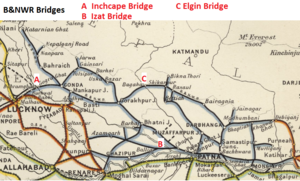Inchcape Bridge: Difference between revisions
New page created |
Map added and minor additions |
||
| Line 1: | Line 1: | ||
Modern name ‘Manjhi Railway Bridge’ | |||
[[File:B&NWR Bridges ABC.png|thumb|B&NWR Bridges - '''Inchcape Bridge]]''' marked '''A''' on map | |||
The '''Inchcape Bridge''' carried the ‘[[Bengal and North-Western Railway]]’(B&NWR) ‘Chupra-Benares-Allahabad Branch’ to the west of Revelganj to Bakulaha and the line opened opened 7 February 1912. The line became described as part of the [[B%26NWR_Lines_Owned_and_Worked#Ganga-Gogra_Doab_Lines| ‘Ganga-Gogra Doab Mainline’]] | The '''Inchcape Bridge''' carried the ‘[[Bengal and North-Western Railway]]’(B&NWR) ‘Chupra-Benares-Allahabad Branch’ to the west of Revelganj to Bakulaha and the line opened opened 7 February 1912. The line became described as part of the [[B%26NWR_Lines_Owned_and_Worked#Ganga-Gogra_Doab_Lines| ‘Ganga-Gogra Doab Mainline’]] | ||
This bridge over the Gogra River, built in 1909-10, consisted of eighteen 200 foot( | This bridge over the Gogra River (modern name Ghaghara River near confluence with Ganges ), was built in 1909-10, consisted of eighteen 200 foot( 61mtr) through girder spans on brick piers, 36 feet high founded on circular brick wells sunk 97 feet below low-water level. The bridge carried a single metre gauge([[Rail_gauge_#Metre_Gauge|MG]]) track<ref name=InstCiv>[https://www.icevirtuallibrary.com/doi/abs/10.1680/ijoti.1937.14679 Instition of Civil Engineers, London ‘The reconstruction of the Incape Bridge, Bengal and North Western Railway, 1937’]; Retrieved 17 Apr 2020</ref>. | ||
The bridge was named the ‘Inchcape Bridge’ after James Lyle Mackay, Ist Earl of Inchcape, who had been appointed President of the Bengal Chamber of Commerce in 1890, a member of the Legislative Council of the Viceroy of India in 1891 and a member of the Council of the Secretary of State for India in 1897. | The bridge was named the ‘Inchcape Bridge’ after James Lyle Mackay, Ist Earl of Inchcape, who had been appointed President of the Bengal Chamber of Commerce in 1890, a member of the Legislative Council of the Viceroy of India in 1891 and a member of the Council of the Secretary of State for India in 1897. | ||
<ref>[https://www.gracesguide.co.uk/James_Lyle_Mackay Grace’s Guide ‘James Lyle Mackay’]; Retrieved 17 Apr 2020</ref>. | <ref>[https://www.gracesguide.co.uk/James_Lyle_Mackay Grace’s Guide ‘James Lyle Mackay’]; Retrieved 17 Apr 2020</ref>. | ||
==Later History== | |||
In the Bihar earthquake of the 15 Jan 1934, two of the girders were overthrown and fell into the dry bed of the river <ref name=InstCiv/>. Reconstruction was in progress in 1937 and the bridge was reopened. | |||
The bridge is now named the ‘Manjhi Railway Bridge’ | |||
==References== | ==References== | ||
Revision as of 10:29, 26 November 2020
Modern name ‘Manjhi Railway Bridge’

marked A on map
The Inchcape Bridge carried the ‘Bengal and North-Western Railway’(B&NWR) ‘Chupra-Benares-Allahabad Branch’ to the west of Revelganj to Bakulaha and the line opened opened 7 February 1912. The line became described as part of the ‘Ganga-Gogra Doab Mainline’
This bridge over the Gogra River (modern name Ghaghara River near confluence with Ganges ), was built in 1909-10, consisted of eighteen 200 foot( 61mtr) through girder spans on brick piers, 36 feet high founded on circular brick wells sunk 97 feet below low-water level. The bridge carried a single metre gauge(MG) track[1].
The bridge was named the ‘Inchcape Bridge’ after James Lyle Mackay, Ist Earl of Inchcape, who had been appointed President of the Bengal Chamber of Commerce in 1890, a member of the Legislative Council of the Viceroy of India in 1891 and a member of the Council of the Secretary of State for India in 1897. [2].
Later History
In the Bihar earthquake of the 15 Jan 1934, two of the girders were overthrown and fell into the dry bed of the river [1]. Reconstruction was in progress in 1937 and the bridge was reopened.
The bridge is now named the ‘Manjhi Railway Bridge’
References
- ↑ 1.0 1.1 Instition of Civil Engineers, London ‘The reconstruction of the Incape Bridge, Bengal and North Western Railway, 1937’; Retrieved 17 Apr 2020
- ↑ Grace’s Guide ‘James Lyle Mackay’; Retrieved 17 Apr 2020